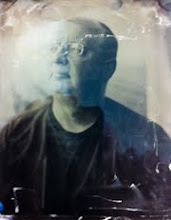Title: "An unbearable weight"
I grew up "back east", in an industrial city huddled against the end of one of the Great Lakes, the pollution rising in the sky like a nasty stain on a Sunday suit. One thing I miss from those days are the violent thunderstorms that would pass through during the summer months. Out here in paradise, thunder is an extreme rarity, something that is remarked upon by everyone on those few occasions when its low rumble is heard off the coast. I think in all the years we've lived here, I can only remember one true thunderstorm.
But in leaving things behind, others are gained. Here I'm able to experience the ever changing sea and sky. The weather has been quite spectacular and changeable this Easter weekend, cycling through a couple of extreme windstorms with respites of sun and warmth. Today there were intriguing cloud formations over the distant hills, pressing down upon the sea. I always feel compelled to make images of these formations, and their relationship with the sea. I'm sure I've seen other photographers' work with clouds and landscape, yet when I make these images I'm only responding to something inside. I'm not trying to follow in anyone's footsteps, or imitate someone's work, I'm just following my own personal imperative. I think that inner urge is what brings something authentic to an artist's work, regardless of whether the particular path is well trodden or not. It's not difficult to differentiate between the work of those who, like Ansel Adams, have a strong affinity for the landscape and the work of those who are simply imitating Adams' work.
I think one of the interesting things about this image is how a photograph changes our perception of reality. I remember reading in the biography of Gerhard Richter a discussion of how his landscape painting work changed from one period to the next. It all revolved around where the horizon line was placed in the composition - it seemed to get lower and lower as the work progressed, which in turn changed the perception of the portrayed landscapes. Through framing, the artist is revealing their own response to the scene before them, and ultimately will shape the viewer's impression of the "reality" of the scene. I've done nothing to manipulate the reality portrayed by this image, except by composition. And yet the perception of that reality is definitely influenced by the compositional choice that I've made. Photographs and their photographers are not dispassionate witnesses to truth or reality; it's a fallacy to think so.


No comments:
Post a Comment